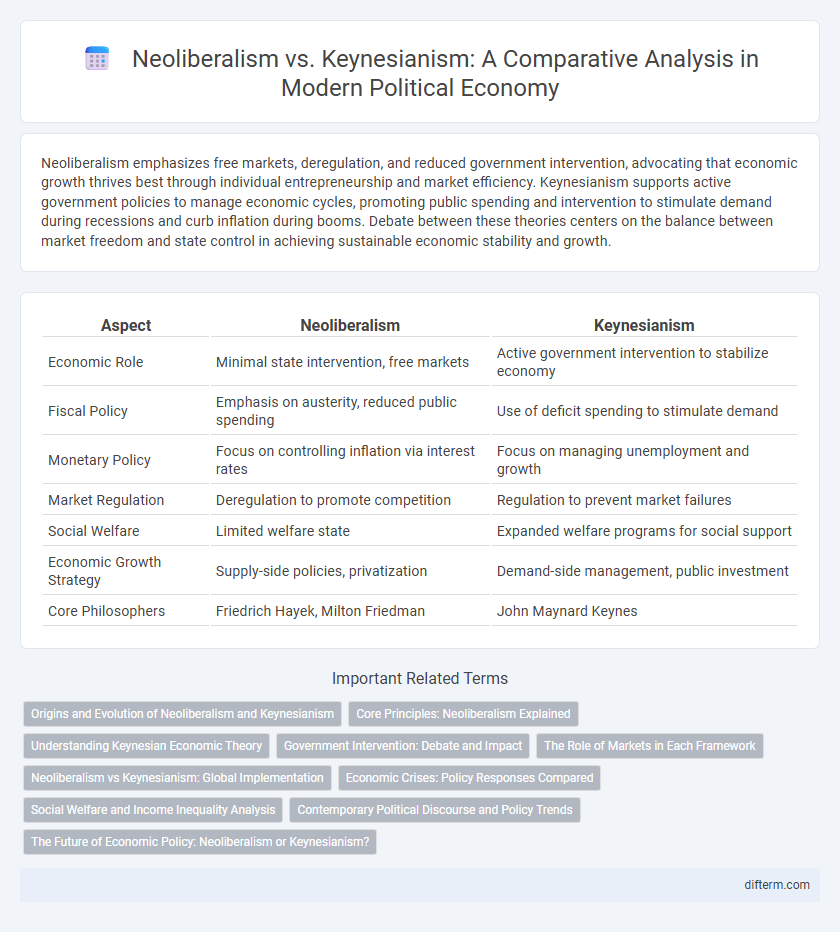Neoliberalism emphasizes free markets, deregulation, and reduced government intervention, advocating that economic growth thrives best through individual entrepreneurship and market efficiency. Keynesianism supports active government policies to manage economic cycles, promoting public spending and intervention to stimulate demand during recessions and curb inflation during booms. Debate between these theories centers on the balance between market freedom and state control in achieving sustainable economic stability and growth.
Table of Comparison
| Aspect | Neoliberalism | Keynesianism |
|---|---|---|
| Economic Role | Minimal state intervention, free markets | Active government intervention to stabilize economy |
| Fiscal Policy | Emphasis on austerity, reduced public spending | Use of deficit spending to stimulate demand |
| Monetary Policy | Focus on controlling inflation via interest rates | Focus on managing unemployment and growth |
| Market Regulation | Deregulation to promote competition | Regulation to prevent market failures |
| Social Welfare | Limited welfare state | Expanded welfare programs for social support |
| Economic Growth Strategy | Supply-side policies, privatization | Demand-side management, public investment |
| Core Philosophers | Friedrich Hayek, Milton Friedman | John Maynard Keynes |
Origins and Evolution of Neoliberalism and Keynesianism
Neoliberalism emerged in the mid-20th century as a response to perceived inefficiencies in Keynesian economic policies, emphasizing free markets, deregulation, and reduced government intervention. Originating from the Mont Pelerin Society in the 1940s, neoliberalism evolved through the 1970s and 1980s during economic crises, influencing policies under leaders like Margaret Thatcher and Ronald Reagan. In contrast, Keynesianism, developed by John Maynard Keynes during the 1930s Great Depression, advocates for active government fiscal policies to manage economic cycles and sustain demand.
Core Principles: Neoliberalism Explained
Neoliberalism centers on free-market capitalism, emphasizing minimal government intervention and deregulation to foster economic growth and individual entrepreneurship. It advocates for reducing public spending on social services while promoting privatization and trade liberalization as mechanisms to increase efficiency and global competitiveness. The approach prioritizes market-driven solutions, asserting that open markets optimize resource allocation and drive innovation.
Understanding Keynesian Economic Theory
Keynesian economic theory emphasizes government intervention to stabilize economic fluctuations through fiscal policy, advocating for increased public spending and lower taxes during economic downturns to boost demand. It challenges the neoliberal focus on free markets and limited state involvement by prioritizing full employment and social welfare. This approach relies on aggregate demand management to address recessions and promote sustainable growth.
Government Intervention: Debate and Impact
Neoliberalism advocates for minimal government intervention in markets, emphasizing free-market principles and deregulation to stimulate economic growth. Keynesianism supports proactive government intervention through fiscal policies such as public spending and taxation to manage economic fluctuations and promote stability. The debate centers on the impact of government roles in addressing unemployment, inflation, and economic crises, influencing policy decisions worldwide.
The Role of Markets in Each Framework
Neoliberalism emphasizes minimal government intervention, championing free markets as the most efficient allocators of resources and drivers of economic growth. In contrast, Keynesianism supports active government participation to correct market failures and stabilize economic fluctuations through fiscal and monetary policies. Both frameworks acknowledge markets' significance but diverge on the extent of state involvement to achieve economic stability and social welfare.
Neoliberalism vs Keynesianism: Global Implementation
Neoliberalism emphasizes free-market policies, deregulation, and reduced government intervention, influencing economic reforms in countries such as the United States, United Kingdom, and Chile since the 1980s. In contrast, Keynesianism advocates for active government spending and fiscal stimulus to manage economic cycles, prominently shaping post-World War II Western economies through policies like the New Deal and the European welfare state expansion. The global implementation of neoliberalism has often led to market liberalization and privatization in developing nations, while Keynesianism's influence persists in government responses to economic crises and ongoing public investment strategies.
Economic Crises: Policy Responses Compared
Neoliberalism emphasizes market self-regulation and austerity measures during economic crises, advocating for reduced government intervention and deregulation to stimulate growth. Keynesianism supports active fiscal policies, including increased public spending and government intervention, to boost demand and mitigate recession impacts. Empirical evidence from the 2008 financial crisis reveals Keynesian stimulus packages often accelerated recovery, while strict neoliberal austerity in Europe correlated with prolonged downturns and social unrest.
Social Welfare and Income Inequality Analysis
Neoliberalism emphasizes limited government intervention in social welfare, advocating for market-driven solutions that often reduce public spending on social programs, leading to increased income inequality. Keynesianism supports active government intervention to expand social welfare through fiscal policies aimed at reducing unemployment and redistributing wealth, which tends to lower income inequality. Empirical studies show that countries adopting Keynesian policies typically experience more robust social safety nets and narrower income gaps compared to those adhering strictly to neoliberal frameworks.
Contemporary Political Discourse and Policy Trends
Neoliberalism emphasizes free markets, deregulation, and individual entrepreneurship as drivers of economic growth, influencing contemporary political discourse with policies promoting privatization and reduced government intervention. Keynesianism advocates for active government spending and fiscal policies to manage economic cycles, informing debates on public investment and social welfare programs in many progressive policy frameworks. Current policy trends reflect a hybrid approach, where governments balance market-friendly reforms with targeted state interventions to address inequality and economic instability.
The Future of Economic Policy: Neoliberalism or Keynesianism?
Neoliberalism prioritizes free markets, deregulation, and limited government intervention, promoting economic growth through privatization and global trade. Keynesianism advocates for active fiscal policies, government spending, and regulation to stabilize economies and reduce unemployment during downturns. The future of economic policy may involve blending neoliberal market efficiencies with Keynesian demand management to address inequality and ensure sustainable growth.
Neoliberalism vs Keynesianism Infographic

 difterm.com
difterm.com